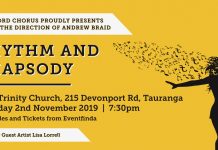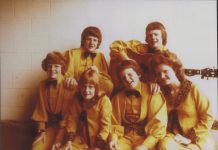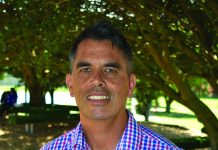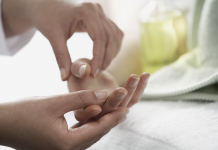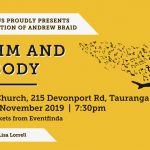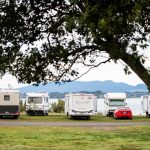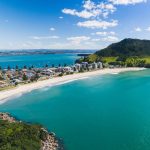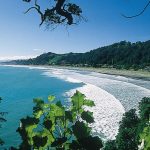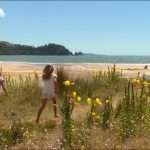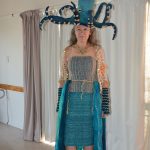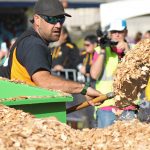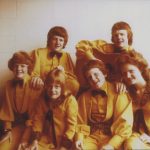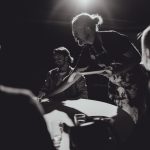
Overlooking the beautiful shimmering waters of Rangataua bay, All Saints church stands on the oldest consecrated church land in Tauranga. Built to last longer and after everything else, it remains spiritually fixed on its foundations. The only visible portion left from the earlier churches is the roof built from kauri.

Maungatapu, a large raupō building about
fifty feet long and thirty feet broad.
The Early Years (1828-1836)
The history of All Saints church, Maungatapu goes as far back as 1836. It stands on what was the site of the Maungatapu Pā, on a hill overlooking Opopoti, before the new highway bisected the site, and the pa buildings affected had to be shifted to the present site on the flat by the beach. The local iwi, Ngāti Hē and Ngāi te Ahi wholeheartedly accepted Christianity.
The very first church was made of raupō (bulrush). Reverend Henry Williams and Thomas Chapman were the visiting clergymen at that time. The first recorded missionary visits to Maungatapu Pā were the Rev. Henry Williams in 1828 and Thomas Chapman in 1831. In his book, ‘Brown and the Elms’ Charles Vennell wrote, “After being ship-bound by a gale, the missionaries landed at Maungatapu on Sunday, 23 October, 1831.” Rev. Williams’s journal records, “…but rain coming on, they proposed that we should adjourn to a large raupo building…about fifty feet long and thirty feet broad. All sat in order and were attentive to what we had to say; it was particularly gratifying…they appear to remember that we were the first who came here and to regard us as old acquaintances…it is doubtless an important field for missionary work and I trust, ere long, something may be done.”
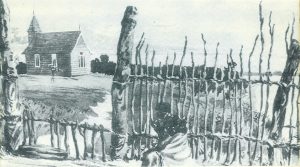
A wooden Maungatapu Chapel replaces the raupō building (1850)
At Maungatapu the chiefs Nuka, Te Mutu, and Kiharoa led their people in such peaceful endeavours that in 1850, by their own efforts, and on their own land, the local iwi built a small wooden church, replacing the raupō. They had actually launched the project a year earlier but had run into difficulties in acquiring timber as Maungatapu was covered largely with scrub and ti tree – not trees suitable for building. This caused some trouble with the Otumoetai iwi as they had tried to take a sacred tree from Otumoetai for this, to them a worthy purpose. Archdeacon Brown was actively involved in the project managed to affect an amicable compromise and so he lent pit-saws to help with the building. The church was simply known as Maungatapu chapel.
Kauri chapel constructed (1862)
Over the years the chapel fell into decay with age, so a new church was built from kauri in 1862, and consecrated ‘Christ’s Church.’ In 1864, a year after the Battle of Gate Pā, Lieutenant Horatio Robley sketched the Maungatapu church, a painting which is now part of the National Museum Collection. The last mention of Archdeacon Brown preaching at Maungatapu church was in July 1880 according to Charles Vennell (NZ Historian). Albert Nesbit Brown died 7 September 1884 and buried in the Mission Cemetery, Tauranga.
Standing strong against Mother Nature
Over the years the church has had its share of disasters. Its banks threatened by slips, caused by the surge of high tides. In 1952, during a very bad storm, the church was blown off its foundation. Later alterations and additions were made and the church was moved further back from the cliff, but even the Wahine storm of 1968 rattled the building and bracing was needed thereafter.
More history than meets the eye
Ray Haua, a stalwart of All Saints from the 1950’s through the 1990’s, told that Rev. William Goodyear and his wife Catherine drove over muddy tracks (roads of those days), with an organ in their trap (horse and cart), to take the Sunday services. Ray also spoke about going to the church on one occasion and finding it occupied by pigs (for the second time in its history). Ray and his wife Phyllis looked after the grounds for many years. Miss Elizabeth Birley had great concerns for the church and was active in caring for it, and so the church was re-hallowed by Bishop Panapa in 1959 and in that year the church was renamed All Saints.
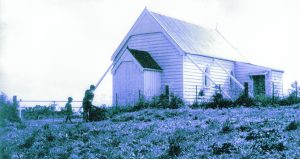
– Frame supports are a result of
the Wahine Storm of 1968
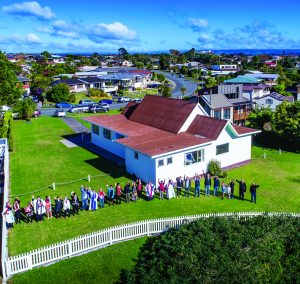
rests proudly within a thriving urban community. (Photo – Andy Belcher)
Moving forward
For a very long time this church had been under the guardianship of Holy Trinity and the Pākehā congregation of All Saints and during that time it has celebrated its 150th anniversary on the 14th September 1986 and a 175th anniversary on the 28th August 2011. The church was handed back to Te Manawa o te Wheke (the Māori Anglican Diocese), Bishop Ngarahu Katene on Sunday the 29th of May 2016. This year (2018) the All Saints Anglican church is 182 years old.




